Johnny Molson: On the last episode of the Wizard’s Roundtable, we were talking about how long you should let your ads run. On one hand, you don’t want to leave them on so long that they become stale. On the other hand, you don’t want to take them off so quickly that people miss the message. And it kind of brings up one of these weird paradoxes that exists in advertising. You need to be consistent so that people always know that it’s you. McDonald’s doesn’t go changing all their colors and decide that they want a different logo every week. It’s always the same thing, right? But at the same time, you need to be different and surprising and unpredictable. So how do you stay consistent, but also be unpredictable at the same time? And one of the ways we do this is with something called brandable chunks. And it’s a way that you can take a handful of ideas and keep them consistent through all of your advertising in new and different and surprising ways.
So today on the Wizard’s Roundtable, we have Chris Maddock in Austin, Texas. The whole idea of brandable chunks originated with him. Jeff Sexton is in Pensacola, Florida, and he uses brandable chunks regularly in the campaigns he builds as well. So let’s start with Jeff Sexton, who is talking about just a general definition of what brandable chunks are.
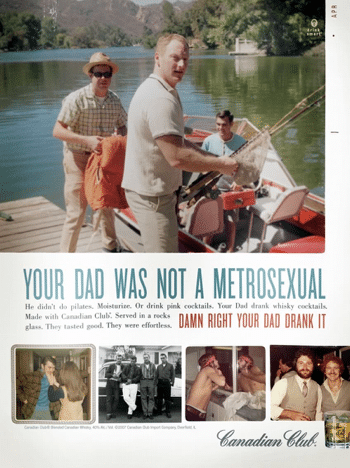 Jeff Sexton: It’s campaign-centric, right? And you want to embed claims and positioning statements without being boring or overly repetitive or predictable. So you want consistency with variety. Not every chunk is used in every ad. You mix them up, right? Chunks are put in different places from ad to ad, and you can vary how you phrase them. And you can start playing with them once they become expected. You start throwing them curve balls. But I always thought that this Canadian club campaign was a fantastic example of brandable chunks.
Jeff Sexton: It’s campaign-centric, right? And you want to embed claims and positioning statements without being boring or overly repetitive or predictable. So you want consistency with variety. Not every chunk is used in every ad. You mix them up, right? Chunks are put in different places from ad to ad, and you can vary how you phrase them. And you can start playing with them once they become expected. You start throwing them curve balls. But I always thought that this Canadian club campaign was a fantastic example of brandable chunks.
Just to give you some background on the campaign. At the time that they were commissioned to do this Canadian club was losing market share and nobody was drinking it. It was considered an old man’s drink. It’s what your dad drank, right? And so they were like, “Well, we gotta reframe that. Like, you’re damn right, your dad drank it.” It might be too small for you to read the actual copy rather than the headline and the tagline. I put it over here in white and you can see the red part is the brandable chunks. “Your dad drank whiskey cocktails made with Canadian club served in a rocks glass. They tasted good. They were effortless.” So the headline is always different. The bridge is always different. And the tagline is always the same. So again: new headline, new bridge, but he drank whiskey cocktails made with Canadian club in a rocks glass.
They didn’t use the exact same ones in the exact same way, but they’re recognizably the same. “They drank CC and Ginger’s, they were smooth. They mixed really well. He drank cocktails. But they were whiskey cocktails, made with Canadian Club, served in a rocks glass. They tasted good. They were effortless.” So you have this nice repetition. That’s always on theme, but they’re always phrased a little differently. And there’s enough variety that you’re interested.
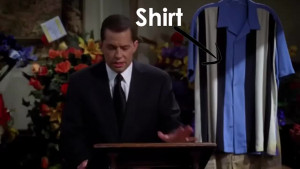 Chris Maddock: I like to use the example of Chuck Lorre, who up until two years ago had the most popular comedy show on television. And that spanned back from Two and a Half Men on into The Big Bang Theory. I think it was 18 odd years. And he does something remarkable with his shows.
Chris Maddock: I like to use the example of Chuck Lorre, who up until two years ago had the most popular comedy show on television. And that spanned back from Two and a Half Men on into The Big Bang Theory. I think it was 18 odd years. And he does something remarkable with his shows.
He makes you care about his characters in 22 minutes a week. That’s how long he has. He’s got 22 minutes a week and people halfway into a season will have feelings for his characters. And it’s because of how he caricatures them and he dresses them and he does so with brandable chunks. So if you think of Charlie Sheen’s character on Two and a Half Men, he wears the bowling shirt. And then Sheldon with the Brad Pitt style, long shirt, short shirt over that. Those are brandable chunks. And then things they say are brandable chunks. Okay.
Sheldon Cooper: Buzzinga, Buzzinga, Buzzinga, I don’t care, Buzzinga, Buzzinga, Buzzinga.
Chris Maddock: So it’s quick. It’s like character — when you do it in an ad, you’re caricaturing your ad to some degree. You’re giving it again blown up elements, more than what is possibly natural speech or whatever else, so that those things are highlighted and felt. And if they’re brand important elements, that’s really important that they’ll be remembered.
Johnny Molson: So how does a brandable chunk differ from a tagline?
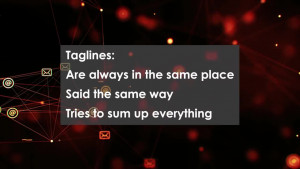 Chris Maddock: I would say it’s position and in the way that it’s used, it’s effectiveness. So taglines come at the end of an ad and they sum up something and they’re great for awhile. And they’re good at reaching that point of normalcy, of expectation. But they then don’t break it. They can be used in different places in a piece of advertising and they change.
Chris Maddock: I would say it’s position and in the way that it’s used, it’s effectiveness. So taglines come at the end of an ad and they sum up something and they’re great for awhile. And they’re good at reaching that point of normalcy, of expectation. But they then don’t break it. They can be used in different places in a piece of advertising and they change.
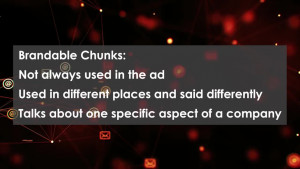 Jeff Sexton: Yeah. So if I’d sum it up, a tagline is always used in the same place. Usually at the sign off or at the end. It’s always phrased exactly the same way. And it typically is trying to sum up the whole of the company. Whereas a brandable chunk is not always used in the ad and it’s always varying in where it’s used. And it’s phrased differently from time to time. You can play with it. And it’s usually talking about one specific aspect of the company. One specific point.
Jeff Sexton: Yeah. So if I’d sum it up, a tagline is always used in the same place. Usually at the sign off or at the end. It’s always phrased exactly the same way. And it typically is trying to sum up the whole of the company. Whereas a brandable chunk is not always used in the ad and it’s always varying in where it’s used. And it’s phrased differently from time to time. You can play with it. And it’s usually talking about one specific aspect of the company. One specific point.
Chris Maddock: I think the Wiz has trained people well enough to know that it’s about the customer. And the customer varies too much. When everything was about the brand, those were easier. When people really started to understand that great ads are about the customer, I think it’s harder to make a great tagline. But it’s easy to use brandable chunks, or more important to use brandable chunks, to sum up all the little stuff that you’re talking about Jeff.
Jeff Sexton: A tagline is very corporate and brandable chunks are very people-centric, right? If your brand is a character and it’s human, then it’s going to speak like a human. Humans have go-to phrases, but they don’t have taglines.
Johnny Molson: With that being said, then what can qualify for a brandable chunk?What’s the ingredients? What do you put into one?
Chris Maddock: Well it’s “rectangle, square” there on taglines. Taglines are brandable chunks. But I think to me, they should be brand important ideas. Or those things you choose to just be in there because they’re awesome. For me, they come from sticky pieces of verbiage that I’ve written or that I splatted down on paper. And so I think they have a little magic to them. I identify them when I’m talking about brand important ideas and they seem to have some shininess to them. Some sparkle.
Jeff Sexton: Yeah. It’s kind of that overlap between what Chris just said. A brand important idea or positioning statement and a phrase that has some stickiness and some oddness and some magic to it. When those two things overlap, then you get yourself a brandable chunk. And when you have a handful of them then you’ve got some magic for a campaign.
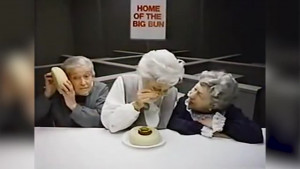 Chris Maddock: Yeah. It’s like, why did Wendy’s after the old lady… I mean, even beyond her, they should’ve said “Where’s the beef?” Just having it there in that ad, I mean, that’s the most memorable Wendy’s ad of all time by far. I think it was one or two commercials. I don’t remember. I’m not sure Wendy’s ever had a tagline that I remember. But you know, Dave Thomas was a brandable chunk and 100% all beef, the square thing is a brandable chunk. The shakes, I think they used to talk about that more. But I think that they have magic in them and be brand important ideas.
Chris Maddock: Yeah. It’s like, why did Wendy’s after the old lady… I mean, even beyond her, they should’ve said “Where’s the beef?” Just having it there in that ad, I mean, that’s the most memorable Wendy’s ad of all time by far. I think it was one or two commercials. I don’t remember. I’m not sure Wendy’s ever had a tagline that I remember. But you know, Dave Thomas was a brandable chunk and 100% all beef, the square thing is a brandable chunk. The shakes, I think they used to talk about that more. But I think that they have magic in them and be brand important ideas.
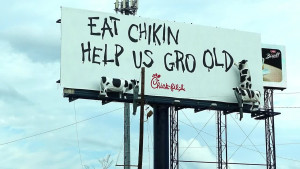 Jeff Sexton: I think that’s important to stress. What Chris just said is, you know, there’s all sorts of stylistic elements that are not verbal phrases that are brandable chunks. So if you went to the work that the Richards Group did for Chick-fil-A when they first started out. The cows are a brandable chunk. Them misspelling the words was a brandable chunk. Eat more chicken was a brandable chunk, right. And every campaign, every ad, every billboard had that. They had the cows, they had the misspelling, they usually had “eat more chicken” of some kind. But they didn’t always have all of them all together all the time. There’s enough variation that they kept it interesting.
Jeff Sexton: I think that’s important to stress. What Chris just said is, you know, there’s all sorts of stylistic elements that are not verbal phrases that are brandable chunks. So if you went to the work that the Richards Group did for Chick-fil-A when they first started out. The cows are a brandable chunk. Them misspelling the words was a brandable chunk. Eat more chicken was a brandable chunk, right. And every campaign, every ad, every billboard had that. They had the cows, they had the misspelling, they usually had “eat more chicken” of some kind. But they didn’t always have all of them all together all the time. There’s enough variation that they kept it interesting.
Johnny Molson: And another example from TV, that, that you give so often which I think is great… You know Kramer is going to come through the door. You just don’t know how Kramer is going to come through the door. And that’s what keeps it interesting.
Chris Maddock: And that’s the whole way to do it. Sometimes I think doing it ahead of time, like “let’s look for brandable chunks or let’s create them…” I think that can be like trying to create comedy. I actually don’t know how that’s done. Maybe it’s done like that. But that seems sort of inorganic and like it could lead to lame stuff.
Johnny Molson: Well that’s an interesting point. And it’s almost exactly what my next question was, but you framed it a little better. At what point do you decide something is a brandable chunk? Because as you said a moment ago, these are brand features. So I think you know that this is a point, this is a point, this is a point… But when do you know something might be a brandable chunk?
Jeff Sexton: Well, I think that there is kind of a balance between planning it out and the organic… On the one hand, the thing that you can’t really plan is something that you put down on paper and you’re like, “Oh, that’s sticky.”
Chris Maddock: That’s the magic to it. But then you plan your subject matter.
Jeff Sexton: So when you have that overlap between it’s brand important, and it’s a sticky phrase, that becomes a brandable chunk. But your list can change. You can throw something out there that you would think was a throw away phrase, and somehow it latches into the public imagination and you get feedback on it. It’s like, “Oh, okay, well, we’re going to play with that some more.”
Chris Maddock: My definition of brandable chunks: I kind of have a brandable chunk for that… It’s that yeah, they should be brand important ideas, but sometimes they just shouldn’t. I think you could have a lot of these if you’re not trying to make money. And your idea is just to attempt to have a blast. And I know some people that are sort of in that game and still in business. But you should have one or two of these: just the crazy funny thing that has no place. And that really is maybe one of the more legitimate brandable chunks.
Jeff Sexton: Attitude and character are as much brand as otherwise “brand or copy points”. And so you having some things that do nothing but express your attitude towards life or your overall viewpoint — it may seem like it’s irrelevant, but it’s actually very, very relevant. And if it’s entertaining too, then you’ve got to have that. Yeah, having a couple of those as go-tos for ads is just gold if you have it.
Johnny Molson: Jeff, you mentioned Chick-fil-A and how, you know there’s going to be a cow, you know, the words are going to be spelled wrong… So there are both visual cues, there might be audio cues. A sound that’s always in a TV ad or a sound that’s always in a radio ad. When I produce things, I’m always kind of looking for those things that when it starts, you know it’s them. But you don’t know what’s necessarily coming next.
So it can be, it can be a number of things, but these are just flags so that, um, you know, you know, that it’s the company. I mean, you’ve got, you’ve got to make some sort of distinctiveness about the company and you say, okay, you know, I know that’s the guy, he always wears the black jeans and he always has a polo shirt on, but it’s always going to be a little different.
Jeff Sexton: You want those things to be different from every other ad in your industry. And one of the more interesting ads from the last Super Bowl was the Tide spot where they would start an ad and you would know that it was a car ad. And they did like five industries… And within a couple seconds, they had so much of the cliches, and then it would be like, “Nope, it’s a Tide ad.”
Johnny Molson: Right.
Jeff Sexton: So you kind of want your brandable chunks to be different from anything that would be cliched for that category.
Chris Maddock: Figure out what the norm is, both for your product category, medium and all those things and run like hell from that. And should you do that well enough, that’s gonna perk up mental ears, keep people with you. So that the sticky stuff, will have something sticky itself to stick against.
Jeff Sexton: I think that if you don’t have any… When we’re talking beyond just the verbal, then you don’t have a consistent theme for your campaign. You probably don’t even have a campaign. And then at that point, what are you doing? You’re not branding. You’re not bonding. You’re just throwing out crap on the air. So in some ways, if you’re going to have a campaign that’s going to be effective, you have to have some level of brandable chunks. I think where it becomes more effective is when you can bring a level of intentionality to it and an awareness of being aware of possible magic, right? So there’s the planning part that we talked about, but there’s also that it grows organically. And sometimes you have to just be aware of what sticks and what actually works in the mind of the public. But understanding them and being intentional about it gives you a huge edge in the advertising game, in my opinion.
Johnny Molson: So I hope that helps. I hope that gives you an idea of how you can keep your ads both consistent and surprising at the same time. It’s an interesting balancing act that a lot of advertisers and a lot of businesses run into. If you have any questions, put them in the YouTube comments, or you are more than welcome to send us an email.
- Are You Paying for Too Much for the Wrong Keywords? - July 15, 2024
- Dominate Your Market Like Rolex — 4 Powerful Branding Lessons - July 3, 2024
- Military-Grade Persuasion for Your Branding - June 25, 2024
- Emotion in Advertising Equals Dollars in Business - December 3, 2024
- 2024: The Year Digital Becomes “Traditional” - July 10, 2024
- MYTH: Everyone goes to Google first - June 26, 2024
